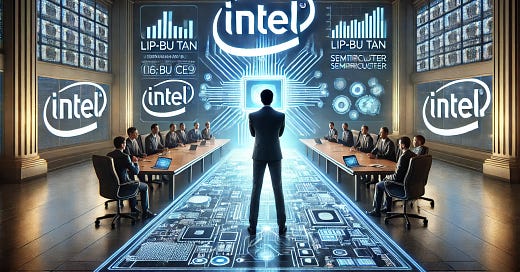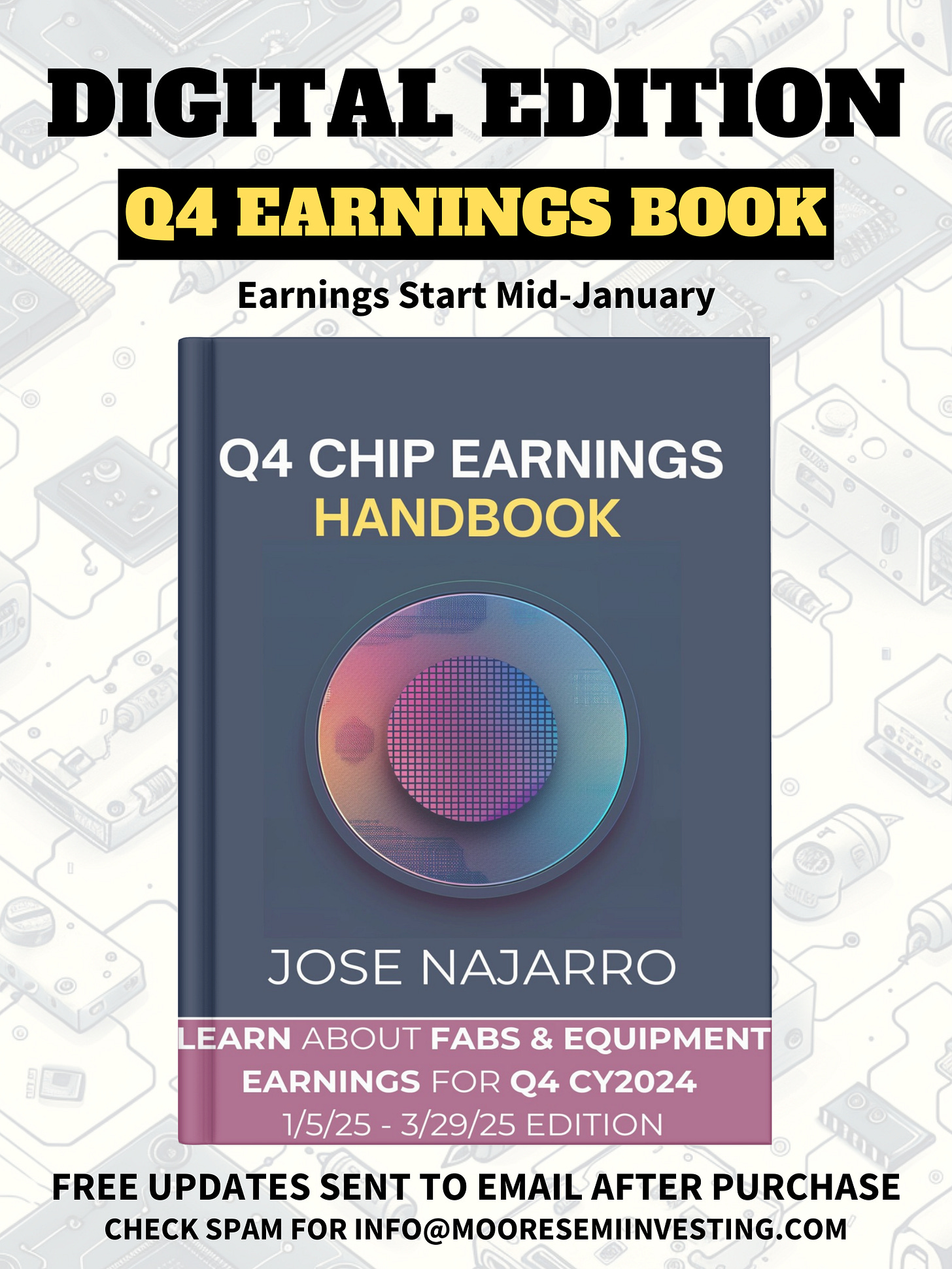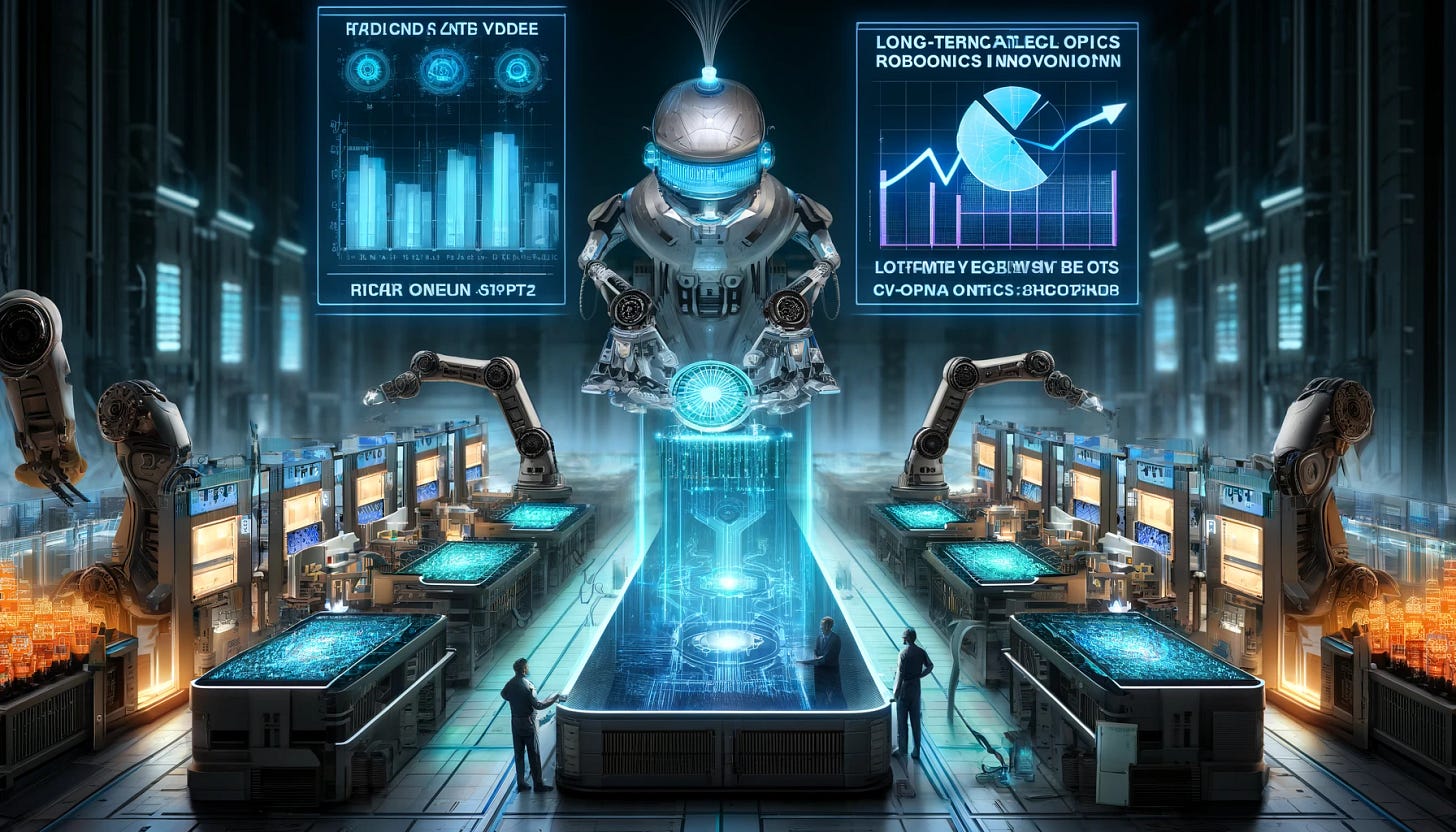🚀 Intel Names Lip-Bu Tan as New CEO for a Bold Turnaround
Welcome, AI & Semiconductor Investors,
Intel's bold move to name Lip-Bu Tan as CEO signals a powerful new chapter, tapping a proven turnaround specialist to rejuvenate its competitive edge and reshape its future in semiconductors.
We also dive into Google's latest push into robotics with Gemini Robotics and Gemma 3, and Teradyne's ambitious vision for the next decade, blending AI-powered testing and robotics innovation.— Let’s Chip In
What The Chip Happened?
🚀 Intel Names Lip-Bu Tan as New CEO for a Bold Turnaround
🤖 Google Pushes Robotics & AI Boundaries with Gemini Robotics & Gemma 3
✨ Teradyne’s Vision for the Next Decade: Test & Robotics Collide!
[Teradyne Charts a Bold Course: AI, Robotics, and New Markets Target 2028 Growth]
Read time: 7 minutes
Intel (INTC)
🚀 Intel Names Lip-Bu Tan as New CEO for a Bold Turnaround
What The Chip: On March 12, 2025, Intel announced that Lip-Bu Tan will take over as CEO, effective March 18. He replaces Interim Co-CEOs David Zinsner and Michelle (MJ) Johnston Holthaus, signaling a major leadership pivot for the chip giant.
Details:
🔑 Proven Turnaround Specialist: Lip-Bu Tan previously served as CEO of Cadence Design Systems from 2009 to 2021, during which Cadence doubled revenue and posted a remarkable 3,200% increase in stock price.
🎯 Boardroom Return: Tan will also rejoin Intel’s board of directors after stepping down last August, bolstering strategic continuity and oversight.
💡 Industry Cred: With over two decades of semiconductor expertise, Tan’s deep relationships across the product and foundry ecosystems could help accelerate Intel’s comeback.
🚀 Leadership Vision: “I am honored to join Intel as CEO,” Tan said. “I see significant opportunities to remake our business in ways that serve our customers better and create value for our shareholders.”
🏭 Manufacturing Edge: Intel’s ongoing push to rebuild process technology and expand its foundry footprint remains a top priority. Tan’s customer-centric track record suggests a fresh approach to drive execution.
📊 Steady Financial Hand: David Zinsner stays as CFO while Michelle Johnston Holthaus remains CEO of Intel Products, ensuring operational and financial continuity alongside new leadership.
Why AI/Semiconductor Investors Should Care: Tan’s appointment comes at a critical time as Intel seeks to regain its competitive edge in both manufacturing and product leadership. His history of transforming companies and forging strong ecosystem ties could be the catalyst for meaningful growth, making this transition particularly noteworthy for investors tracking Intel’s turnaround story.
Moore Semiconductor Investing
📗 [NEW!!] Unlock Q4 Semiconductor Earnings --- 60% OFF (NEW EARNINGS)
What The Chip: Get a front-row seat to the financials shaping the semiconductor industry. This continuously updated e-book by Jose Najarro distills the latest Q4 quarterly insights—from wafer production trends to AI chip breakthroughs—into a single comprehensive resource.
Details:
🔵 Dynamic Updates: Start with giants like TSMC and ASML, then expand to 30+ companies as their Q4 2024 earnings roll in. Earnings are restarting!!
🔵 Broad Coverage: From traditional chipmakers to cutting-edge AI semiconductor players, get the full picture as it emerges.
Why AI/Semiconductor Investors Should Care: This evolving earnings handbook gives you a strategic edge. Understanding quarterly earnings data is crucial for gauging industry health, discovering new growth leaders, and aligning your investment approach with emerging technological waves.
Disclaimer: For educational and informational purposes only. Not financial advice. Consult with a qualified professional before making any investment decisions. Updates are only for the Quarter of Earnings.
Google (GOOG)
🤖 Google Pushes Robotics & AI Boundaries with Gemini Robotics & Gemma 3
What The Chip: On March 12, 2025, Google DeepMind announced two significant AI developments: Gemini Robotics — an advanced “embodied reasoning” platform for robotics — and Gemma 3, the company’s latest open AI model lineup designed to run on minimal hardware.
Details:
🤔 Gemini Robotics Unveiled: Built on Gemini 2.0, this new robotics model enables robots to perform complex, real-world tasks by integrating vision, language, and physical actions seamlessly.
🦾 Enhanced Capabilities with Gemini Robotics-ER: Adds advanced spatial understanding and “embodied reasoning” (ER), letting roboticists control movement through code generation and real-time adjustments to changing environments.
🔧 Partnering with Apptronik: Google DeepMind is teaming up with Apptronik to create humanoid robots powered by Gemini, illustrating Google’s move toward commercial-grade robotics.
✅ Safety & Responsible AI: Clement Farabet, VP of Research, highlighted rigorous safety checks, saying the team employed “extensive data governance and alignment” to ensure lower risks of misuse.
⚡ Gemma 3 Open Models: Available in sizes from 1B to 27B parameters, Gemma 3 is touted as “the most advanced, portable” open model that can run on a single GPU or TPU.
🌐 Global Language Coverage: Gemma 3 supports 140 languages, provides 128k-token context windows, and offers function-calling for more advanced integrations.
🔎 ShieldGemma 2 for Image Safety: A new image safety checker that flags harmful content, enabling developers to tailor solutions for safer AI applications.
Why AI/Semiconductor Investors Should Care: These dual announcements showcase Google’s strategy to unify AI intelligence with robotics and edge devices, potentially creating a new wave of demand for specialized chips. As AI models like Gemini Robotics and Gemma 3 push performance boundaries, hardware makers may see fresh growth opportunities in supplying GPUs, TPUs, and next-generation robotics components.
Teradyne, Inc. (TER)
✨ Teradyne’s Vision for the Next Decade: Test & Robotics Collide!
What The Chip: Teradyne recently held its first Analyst/Investor Day in 20 years on March 11, 2025, unveiling major updates on the test and robotics fronts. Management offered a candid near-term revenue adjustment for 2025 (down from ~15% to a new 5-10% outlook) and discussed long-term bets on AI, co-packaged optics, and advanced robotics.
Details:
🔍 Reduced 2025 Growth Guidance: CEO Greg Smith noted “Q2 revenue will likely be flat to 10% down, instead of the 5-10% rise we anticipated in January.” While Q1 remains intact, second-half visibility remains “cautiously optimistic.”
🤖 Robotics Restructuring & Growth: Executives emphasized a new cost structure in advanced robotics to ensure profitability. “We’re in a marathon, not a sprint,” said Smith. AI-driven robotic solutions (for pallet handling, bin picking, etc.) grew from $1M to $11M in 2024 and could reach $150M in the coming years.
📈 Product Test Division Shake-Up: A newly formed Product Test Division (including LitePoint, Board Test, and a planned acquisition of Quantifi Photonics) will leverage synergies with Teradyne’s dominant Semiconductor Test unit.
⚙️ Key R&D Investments: The team detailed new co-packaged optics initiatives, with Quantifi Photonics accelerating that roadmap. “Silicon photonics and co-packaged optics are absolutely vital,” said Product Test head, Regan Mills.
🚗 Automotive & Power Focus: Wide-band gap semiconductors like gallium nitride and silicon carbide will be tested on Teradyne’s ETS platform. The company acquired Infineon’s internal testing group in Regensburg to sharpen its power test leadership.
💾 Memory Test Gains: EVP Rick Burns shared a goal to become #1 in memory test, citing a track record of rising from 4% to 40% market share. New HBM4 and DDR solutions should bolster memory test revenue in 2025-2026.
🏭 Capital Allocation: CFO Sanjay Mehta reiterated Teradyne’s balanced approach—fund dividends, buy back shares, and pursue disciplined M&A. “We expect robust free cash flow,” he noted, “to enable these priorities sustainably.”
Why AI/Semiconductor Investors Should Care: Teradyne’s pivot to AI-powered test solutions and advanced robotics underscores its ambition to serve top-tier customers pushing the performance envelope. The near-term revenue headwind might weigh on the stock, but the long-term roadmap—cobots, co-packaged optics, power semiconductors—appears robust. It’s a prime example of a well-established test leader positioning itself for the next big AI and electrification waves.
Youtube Channel - Jose Najarro Stocks
[NEW] Semiconductor Q4 Earnings Book — 60% OFF
X Account - @_Josenajarro
Disclaimer: This article is intended for educational and informational purposes only and should not be construed as investment advice. Always conduct your own research and consult with a qualified financial advisor before making any investment decisions.
The overview above provides key insights every investor should know, but subscribing to the premium tier unlocks deeper analysis to support your Semiconductor, AI, and Software journey. Behind the paywall, you’ll gain access to in-depth breakdowns of earnings reports, keynotes, and investor conferences across semiconductor, AI, and software companies. With multiple deep dives published weekly, it’s the ultimate resource for staying ahead in the market. Support the newsletter and elevate your investing expertise—subscribe today!
[Paid Subscribers] Teradyne Charts a Bold Course: AI, Robotics, and New Markets Target 2028 Growth
Executive Summary
*Reminder: We do not talk about valuations, just an analysis of the earnings/conferences
Teradyne, Inc. (Teradyne), a 64-year-old global supplier of automation equipment, recently held its first Analyst and Investor Day in two decades at its North Reading, Massachusetts headquarters. The event showcased new leadership, acquisitions, and a long-term roadmap that aims to more than double the company’s earnings per share (EPS) by 2028, all while adapting to volatile short-term market conditions.
The company, which began in semiconductor test (“Semi Test”), now operates three core divisions:
Semiconductor Test Division (Semi Test): Approximately 75% of 2024 revenue, serving customers that manufacture integrated circuits for computing, automotive, and mobile devices.
Product Test Division (Product Test): About 12% of 2024 revenue, testing assembled electronics, wireless modules, printed circuit boards, and emerging optical components.
Robotics (Advanced Industrial Automation): Roughly 13% of 2024 revenue, offering collaborative robots (cobots) and autonomous mobile robots (AMRs).
Key Financial Metrics
2024 total revenue mix: ~75% Semi Test, 12% Product Test, 13% Robotics
Targeting 15% annual revenue growth from 2024 to 2028
Midpoint target of $8.25 EPS in 2028, compared to an estimated $3.22 EPS in 2024
Aim to keep operating expenses rising at about half the annual revenue growth rate
Notable Management Comments
Gregory Smith, Chief Executive Officer: “We are seeing short-term volatility in semiconductor test, but remain confident in a long-term plan that drives strong earnings growth out to 2028.”
Rick Burns, President of the Semiconductor Test Business: “We think this high-volatility environment creates opportunities for share gains, especially in high-performance computing (HPC) and memory segments.”
Ujjwal Kumar, President of Robotics: “With the advanced robotics market at an inflection, AI-based features are expanding our served market—especially in logistics, life sciences, and emerging segments like construction and agriculture.”
Teradyne’s latest updates include acquiring Quantifi Photonics—an optical test equipment specialist—and forming a new Product Test Division that consolidates aerospace, LitePoint (wireless test), and printed circuit board test. With this restructuring, Teradyne intends to heighten synergies between semiconductor and product test platforms, serving an increasingly vertically integrated customer base that needs robust test solutions from the wafer level to assembled systems.
Growth Opportunities
1. AI-Driven Compute and Mobile
The meteoric rise of artificial intelligence (AI) in data centers and the anticipated transition of AI features into mobile phones (known as “Edge AI”) represent important growth engines for Teradyne. New AI accelerators and high-bandwidth memory (HBM) chips require extensive testing to ensure functionality and reliability. Teradyne leadership expects:
High-Performance Compute (HPC): The cloud-driven compute market reached $2.2 billion in Automated Test Equipment (ATE) size in 2024 and could grow to nearly $3 billion by 2028. Teradyne believes HPC and AI accelerators will form the core of that expansion.
Edge AI in Mobile Devices: By 2026 or later, advanced nodes (2-nanometer and below) and advanced memory interfaces (LPDDR6, next-generation Flash) will power AI-enabled smartphones. Teradyne’s existing presence in testing mobile application processors, memory, and wireless connectivity puts it in a strong position to benefit from new product cycles.
In the words of CEO Gregory Smith: “We’ve seen this wave before—mobile was the big story a decade ago, and now AI is the next big wave. Teradyne is positioned to capture that transition.”







